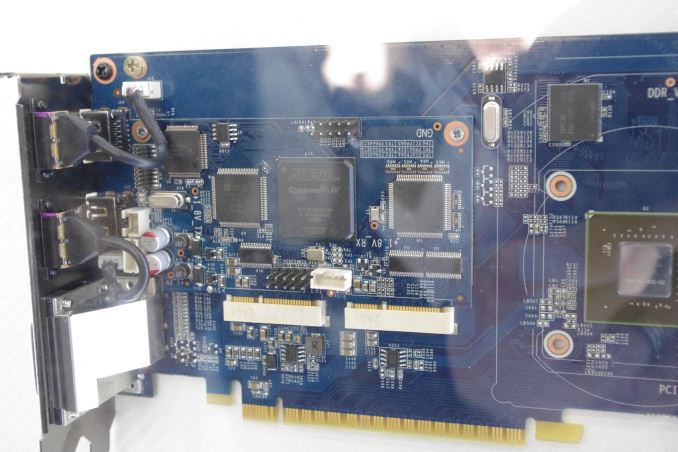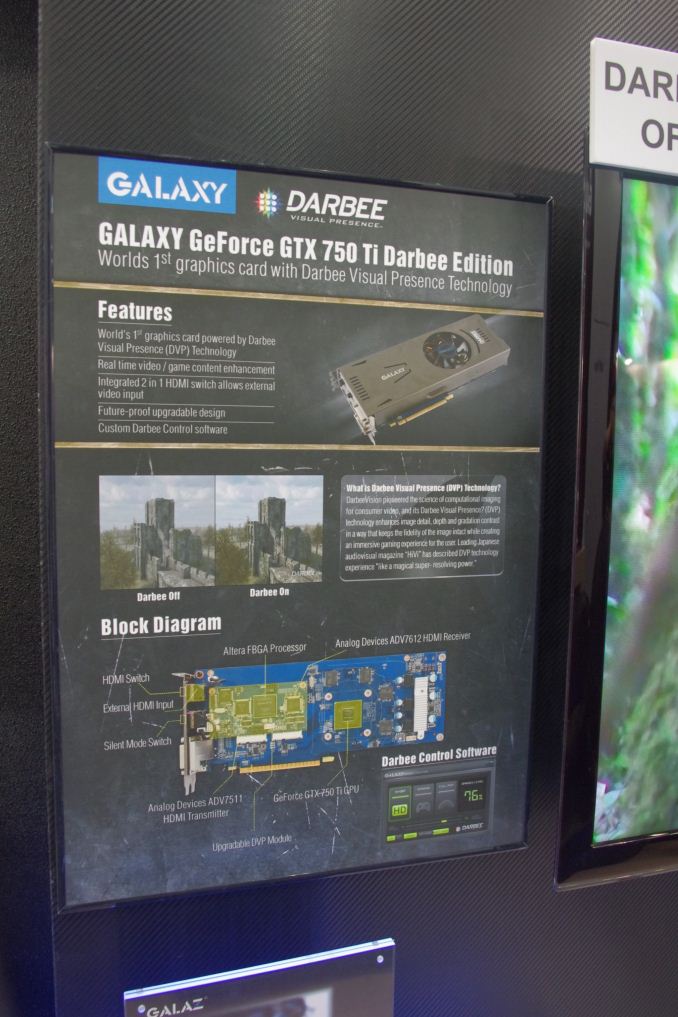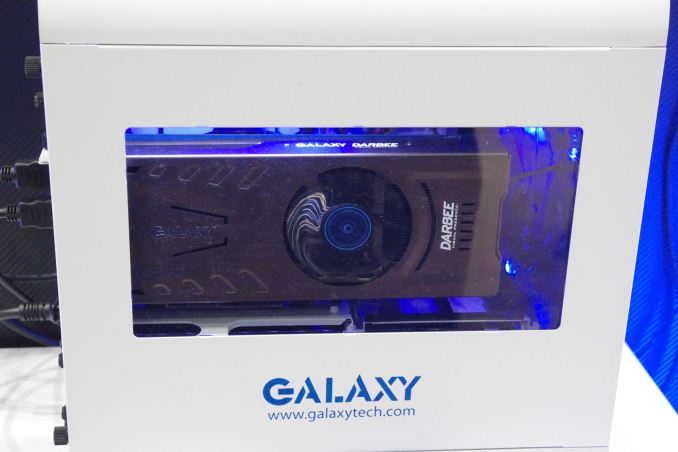Computex 2014: Galaxy Showcases GTX 750 Ti Darbee Edition
by Ian Cutress on June 5, 2014 9:15 PM EST- Posted in
- GPUs
- Galaxy
- GTX 750 Ti
- Darbee

In the realm of photo and film-editing, post processing can make the difference between bad looking media and something epic. The depth of post processing on an image or a video is usually dictated by the level of expertise of the editor or the budget, which might suggest that things could be better. Darbee is a known company that deals in media post-processing in real-time, whereby I have a couple of friends who swear by their custom boxes that use clever manipulation techniques (based on blur-and-subtract algorithms) to bring their home media system to life. What Galaxy has done is combine one of their GPU designs, the GTX 750 Ti, with a Darbee IP, to allow an all-in-one image enhanced graphics card.
The system takes a standard reference design GTX 750 Ti, extends the length, and uses an add-in card containing an Altera Cyclone IV FPGA as well as some other ICs.
The effect is output only on one HDMI port due to the hardware limitations, but users can adjust the depth of the effect from 0% (none) to 100% (full) with the included software. At current the GPU is not equipped for SLI over cabling, however I requested an edition to come to the US, allowing users to hook up three cards and run them all in SLI with the effect on three HDMI panels.
After speaking to a few friends about the technology, an interesting point came to pass. AMD and NVIDIA are currently in a battle for performance. It would not take much for one of these to invest into the Darbee post-processing ecosystem and incorporate it into their technology, thus giving an improved feature set to the brand. However, it was also mentioned how much effect Darbee has on a calibrated display. We now have a contact for Galaxy, so I will see if Ryan has time to look at a sample.
















26 Comments
View All Comments
AZengus - Thursday, June 5, 2014 - link
Interesting, I thought the GTX 750 Ti was not capable of SLI. Perhaps this is a new part?As for the Darbee effect, I have to wonder how much it will add to the cost of the card. The Darbee Darblet (standalone HDMI passthrough device) retails for $270-$320 alone; I can understand it'll be up to the licensee (Galaxy or whoever) to integrate this into the logic board, potentially cutting costs. But it's likely going to be significantly more expensive over a standard 750 Ti.
cheinonen - Thursday, June 5, 2014 - link
Oppo has players that integrate the Darbee processing and they retail for $100 more than the non-Darbee versions. The Lumagen video processors also added it but the cost isn't known on those. So I could see a video card adding it for a markup under $100 since they just need to implement the algorithm and not the full hardware of the Darblet.praktik - Friday, June 6, 2014 - link
I'm not sure what incremental benefit this might offer over *any* nvidia GPU and a madvr+lav filter setup. I don't believe the darbee us anything other than a proprietary mix of a similar approach they bake into hardware they sell. Maybe someone can offer a tangible reason to get this card?SirMaster - Friday, June 6, 2014 - link
I've yet to see any software filters match a Darbee in what it does to the perceived video sharpness/clarity.I'm not saying its not possible, but nobody seems to have cracked the formula yet.
BlueScreenJunky - Friday, June 6, 2014 - link
The more important question is Why would anyone want to replicate the monstruosity that is Darbee ?It's just adding tons of Edge enhancement, the very feature that you should always disable on your TV set. For me it's just like over saturated displays : the image looks more punchy in the store, but I would not watch my movies like that.
surt - Friday, June 6, 2014 - link
+1 ... I look at the Darbee side of the image and think 'yuck'.HisDivineOrder - Friday, June 6, 2014 - link
Good. I'm not the only one thinking this looks like a sharpening filter with some contrast "enhancement" (read: mucking).Yeah, I'll skip this "innovation" I think. Just render the image the way it's meant to be rendered.
nathanddrews - Friday, June 6, 2014 - link
My first instinct is also *insert Vader No!*I have not seen the results first hand, however several HIGHLY respected members on AVS who normally fight against all forms of digital tinkering claim that the Darbee processing is excellent.
Samus - Monday, June 9, 2014 - link
you guys need to see it in person. my friend has a Darblet and it makes DVD's look like Blu-rays when in motion from a distance. still captures don't do it justice, and I agree, just make it look oversharpened.TheRealAnalogkid - Friday, June 6, 2014 - link
I have an Oppo 103-D with Darbee and I'm an ISF trained calibrator (since 1997). I have a Sony 4k television and a Samsung 8500. The Darbee effect is not just "edge enhancement" or any type of oversaturated anything. It improves any picture...even on the most pristine Blu-rays (albeit at lower levels) it adds a clarity to the picture that is unrivaled. I look forward to Darbee being available on more products; Oppo wouldn't add it to their players if it didn't offer a benefit to the picture; I know that Lumagen has added it and that there are many other manufacturers coming out with products including Darbee. I look forward to using Darbee integrated into my next video card!My hope is that the Darbee process doesn't make a "lite" version of their product to meet cheaper products' price points.